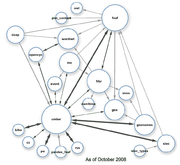
UMBEL
Encyclopedia
UMBEL, short for Upper Mapping and Binding Exchange Layer, is an extracted subset of OpenCyc, providing the Cyc data in an RDF
ontology
based on SKOS
and OWL 2
. According to its Web site, UMBEL "is designed to help content interoperate on the Web."
 UMBEL has two main functions:
UMBEL has two main functions:
UMBEL is a prominent class structure used in Linked Data
, along with OpenCyc, YAGO
and the DBpedia
ontology. Because it is a strict subset of OpenCyc concepts and relationships, mappings to UMBEL can take advantage of the reasoning engines
within Cyc.
Including OpenCyc, UMBEL has about 46,000 formal mappings to DBpedia
, PROTON
and GeoNames
, and provides linkages to more than 2 million Wikipedia
pages (English version). All of its reference concepts and mappings are organized under a hierarchy of 33 different "super types", which are mostly disjoint from one another.
UMBEL was first released in July 2008. Its first production-grade and stable release was version 1.00, released in February 2011.
UMBEL is maintained by Structured Dynamics and Ontotext
.
Resource Description Framework
The Resource Description Framework is a family of World Wide Web Consortium specifications originally designed as a metadata data model...
ontology
Ontology (computer science)
In computer science and information science, an ontology formally represents knowledge as a set of concepts within a domain, and the relationships between those concepts. It can be used to reason about the entities within that domain and may be used to describe the domain.In theory, an ontology is...
based on SKOS
SKOS
Simple Knowledge Organization System is a family of formal languages designed for representation of thesauri, classification schemes, taxonomies, subject-heading systems, or any other type of structured controlled vocabulary. SKOS is built upon RDF and RDFS, and its main objective is to enable...
and OWL 2
Web Ontology Language
The Web Ontology Language is a family of knowledge representation languages for authoring ontologies.The languages are characterised by formal semantics and RDF/XML-based serializations for the Semantic Web...
. According to its Web site, UMBEL "is designed to help content interoperate on the Web."

- It is an upper ontology of about 28,000 reference concepts, designed to provide common mappingData mappingData mapping is the process of creating data element mappings between two distinct data models. Data mapping is used as a first step for a wide variety of data integration tasks including:...
points for relating different ontologies or schemaConceptual schemaA conceptual schema or conceptual data model is a map of concepts and their relationships. This describes the semantics of an organization and represents a series of assertions about its nature...
to one another, and - A vocabularyControlled vocabularyControlled vocabularies provide a way to organize knowledge for subsequent retrieval. They are used in subject indexing schemes, subject headings, thesauri, taxonomies and other form of knowledge organization systems...
for aiding that ontology mapping, including expressions of likelihood relationships distinct from exact identity or equivalence. This vocabulary is also designed for interoperable domain ontologies.
UMBEL is a prominent class structure used in Linked Data
Linked Data
In computing, linked data describes a method of publishing structured data so that it can be interlinked and become more useful. It builds upon standard Web technologies such as HTTP and URIs, but rather than using them to serve web pages for human readers, it extends them to share information in a...
, along with OpenCyc, YAGO
YAGO (database)
YAGO is a knowledge base developed at the Max-Planck-Institute Saarbrücken.The knowledge base contains information harvested from Wikipedia and linked to Wordnet....
and the DBpedia
DBpedia
DBpedia is a project aiming to extract structured content from the information created as part of the Wikipedia project. This structured information is then made available on the World Wide Web. DBpedia allows users to query relationships and properties associated with Wikipedia resources,...
ontology. Because it is a strict subset of OpenCyc concepts and relationships, mappings to UMBEL can take advantage of the reasoning engines
Inference engine
In computer science, and specifically the branches of knowledge engineering and artificial intelligence, an inference engine is a computer program that tries to derive answers from a knowledge base. It is the "brain" that expert systems use to reason about the information in the knowledge base for...
within Cyc.
Including OpenCyc, UMBEL has about 46,000 formal mappings to DBpedia
DBpedia
DBpedia is a project aiming to extract structured content from the information created as part of the Wikipedia project. This structured information is then made available on the World Wide Web. DBpedia allows users to query relationships and properties associated with Wikipedia resources,...
, PROTON
PROTON
The PROTON Ontology is a basic upper-level ontology that contains about 300 classes and 100 properties, providing coverage of the general concepts necessary for a wide range of tasks, including semantic annotation, indexing, and retrieval of documents.Its design principles can be summarized as:#...
and GeoNames
GeoNames
GeoNames is a geographical database available and accessible through various Web services, under a Creative Commons attribution license.- Database and web services :...
, and provides linkages to more than 2 million Wikipedia
Wikipedia
Wikipedia is a free, web-based, collaborative, multilingual encyclopedia project supported by the non-profit Wikimedia Foundation. Its 20 million articles have been written collaboratively by volunteers around the world. Almost all of its articles can be edited by anyone with access to the site,...
pages (English version). All of its reference concepts and mappings are organized under a hierarchy of 33 different "super types", which are mostly disjoint from one another.
UMBEL was first released in July 2008. Its first production-grade and stable release was version 1.00, released in February 2011.
UMBEL is maintained by Structured Dynamics and Ontotext
Ontotext
Ontotext is a Bulgarian software company headquartered in Sofia. It is the semantic technology branch of . Its main domain of activity is the development of software products and solutions based on the Semantic Web languages and standards, in particular RDF, OWL and SPARQL.- Co-developer :*Open...
.

